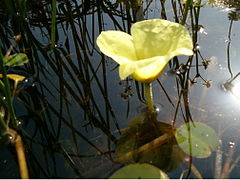Hydrocleys nymphoides
| Hydrocleys nymphoides | ||
|---|---|---|
 Flor de Hydrocleys nymphoides, Jardín Botánico de Berlín | ||
| Taxonomía | ||
| Reino: | Plantae | |
| División: | Magnoliophyta | |
| Clase: | Liliopsida | |
| Orden: | Alismatales | |
| Familia: |
Alismataceae Takht. ex Cronquist | |
| Género: | Hydrocleys | |
| Especie: |
H. nymphoides (Humb. & Bonpl. ex Willd.) Buchenau 1868 | |
Hydrocleys nymphoides (amapolita del agua) es una especie de plantas de la familia Alismataceae, antes Limnocharitaceae.

Distribución y hábitat
[editar]Es endémica de Guatemala, Antillas Neerlandesas, Puerto Rico, Trinidad y Tobago, Guyana, Surinam, Venezuela, Brasil, Bolivia, Colombia, Ecuador, Argentina y Paraguay.
Descripción
[editar]Alcanza entre 15 y 30 cm de altura. Es una planta herbácea, caduca, estolonífera, acuática y perenne. Hoja brillante, simple, gruesa, redondeada, verde oscura, de 5-20 cm de diámetro, forma de las bases acorazonadas; típicamente flota, pero ocasionalmente sobresale arriba. 3-pétalos, amarillos, de 5 cm de diámetro, con el centro rojo pardo al centro, estambres numerosos y negros o castaños; los estambres apenan salen de la superficie. Las flores duran un día, pero su floración en sucesión en un largo periodo veraniego.
Taxonomía
[editar]Hydrocleys nymphoides fue descrita por (Humb. & Bonpl. ex Willd.) Buchenau , y publicado en Index Criticus Butomacearum, Alismacearum, Juncaginacearum 9. 1868.[1]
- Hydrocleys azurea Schult.f.
- Hydrocleys commersonii Rich.
- Hydrocleys humboldtii (Rich.) Endl.
- Limnocharis commersonii (Rich.) Spreng.
- Limnocharis humboldtii Rich.
- Limnocharis nymphoides (Humb. & Bonpl. ex Willd.) Micheli
- Sagittaria ranunculoides Vell.
- Stratiotes nymphoides Humb. & Bonpl. ex Willd.
- Vespuccia humboldtii (Rich.) Parl.[2]
Referencias
[editar]- ↑ «Hydrocleys nymphoides». Tropicos.org. Missouri Botanical Garden. Consultado el 3 de julio de 2013.
- ↑ Hydrocleys nymphoides en PlantList
- USDA, ARS, National Genetic Resources Program. GRIN. National Germplasm Resources Laboratory, Beltsville, Maryland. https://web.archive.org/web/20140515212834/http://www.ars-grin.gov/cgi-bin/npgs/html/taxon.pl?416499 (24 dic 2007)
Enlaces externos
[editar]- http://www.mobot.org/gardeninghelp/plantfinder/Plant.asp?Code=B812 Archivado el 10 de agosto de 2010 en Wayback Machine.
Text is available under the CC BY-SA 4.0 license; additional terms may apply.
Images, videos and audio are available under their respective licenses.
